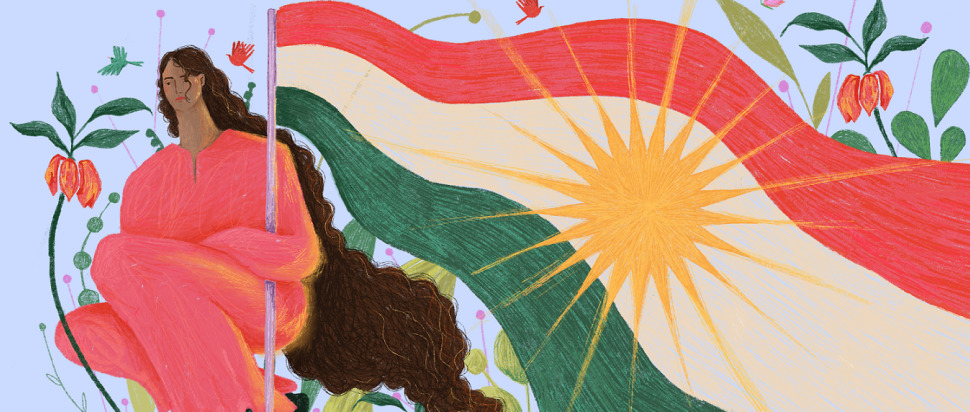Home Country: Orsola Casagrande on Kurdistan + 100
Orsola Casagrande introduces Kurdistan + 100, an anthology of speculative fiction which seeks to embed the Kurdish identity in the historical record
In my four years studying Middle Eastern studies at university, Kurdistan was only once mentioned in passing. Although the geographic area of Kurdistan spans Iraq, Syria, Turkey and Iran, scholarship on Kurdish history, resistance, languages or cultural identity has been denied significant attention in the Middle Eastern canon. The Kurds represent the largest nation in the world without a state; their dismissal from traditional scholarship is not mere oversight but rather a deliberate attempt to erase a significant group of people from the historical record.
It is this void that writers Orsola Casagrande and Mustafa Gündogdu seek to rectify with their anthology Kurdistan + 100. But rather than approaching the anthology as an archival work, the editors have asked their 12 contributing writers to imagine what Kurdistan will look like by the year 2046, a date that marks 100 years since the Kurdish Iranian state of Mahabad was dismantled by the Soviets, after just one year of its existence. Although Mahabad was only realised for Iranian Kurds, it occupies an important role in the national imagination for Kurds living outside of Iran, as the closest they have been to realising their own nation-state. In each of their stories, the writers are invited to negotiate with both past and future.
The stories in Kurdistan + 100 reveal the myriad ways in which the future can be approached as a political ideal. But the first story in the collection – Waiting for the Leopard by Sema Kaygusuz, who represents the Turkish-Kurdish side – strikes a particularly emotional chord. Kaygusuz likens the erasure of Kurds to the extinction of nature, and presents us with a barren world devoid of joy, community and familial bonds. It is a chilling narrative, made all the more frightening for our present proximity to this imagined future.
However, this foreboding entry is not a common theme amongst the stories. In fact, when I sat down with Casagrande to talk about the anthology, she argued that it is actually hope which thematically unites the stories. Hope for a new world has been the driving force for the Kurdish resistance, and their attempts for autonomy have always signalled the potential for alternative realities. Casagrande is quick to point to the defacto autonomous region of Rojava in Northern Syria, as an example of this.
Kurdish resistance leaders in Rojava are “stubbornly trying to build a new and different society,” Casagrande argues, “based on equality, women's liberation, respect and care for the environment, promotion of language and cultural identities.” Indeed, Rojava’s experimentation with implementing anarchistic and feminist ideology marks it as a profoundly hopeful political project. Kurdish resistance, Casagrande emphasises, is not merely about securing autonomy, it is also about building a kinder society. The Kurds refer to hope as hêvî, and it is this optimism that we witness in both the anthology and in real life events.
Gender in particular has always been central to nationalism, with women’s bodies often used to represent the microcosm of the nation and its imagined boundaries. Here too, Kurdistan + 100 presents us with alternative recourse. Women are presented not as passive victims of history but active agents shaping the national narrative. The story titled My Handsome One by Selahattin Demirtaş presents us with a familial tale: a daughter continues her father’s political legacy by fighting for a free Kurdish state.
Demirtaş is a man but his vision of freedom is that of a woman leading the resistance. Casagrande also points to the refusal of Kurdish women in Syria to let the Islamic State infringe upon their bodily autonomy. “Women have been in the front line in Syria, fighting the 'darkness' as they called it, the misogynist and patriarchal mentality promoted by the Islamic State,” Casagrande says. “Women refused to allow the Islamic State to use their bodies as a battlefield and took up arms to defend themselves.”
The gendered concerns of Kurdish resistance feel especially pertinent in this present moment: Kurdistan + 100 will be released almost five months after Kurdish-Iranian Jîna 'Mahsa' Amini was killed in police custody in Iran. The subsequent revolution in Iran is notable for its focus on women, but the movement has also been criticised for its failure to acknowledge its roots in the Kurdish resistance. Jîna Amini is frequently referred to by her Persian name 'Mahsa', while the now infamous rallying cry ‘‘woman, life, freedom“ is a Kurdish slogan that has been appropriated into Persian.
“The Kurds in Iran are trying to dismantle the state,” explains Casagrande, so that the rights of ethnic minorities have been largely ignored in favour of a pan-Iranian identity that does little to address their anti-imperialist or anti-colonial demands. Although this anthology cannot solely rectify this erasure, it is a dazzling contribution to the sustained efforts of the Kurds to sustain their hopeful visions for the future.
Kurdistan + 100 is out on 23 Feb with Comma Press
